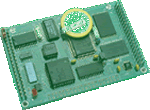16-bit external data bus microprocessor module,
300 KHz ADC/DAC, 256K
W 16-bit Flash, 16-bit SRAM

Specifications:
Measuring 3.6 x 2.3 x 0.3 inches, the A-Engine86^(TM) (AE86) is a C/C++ programmable microprocessor module based on a 40 MHz, 16-bit CPU (Am186ES, AMD). The AE86 is ideal for industrial process control and high-speed data acquisition.In addition to offering a 16-bit external data bus, the AE86 supports on-board 512 KB 16-bit Flash and up to 512 KB 16-bit battery-backed SRAM. All chips are surface-mounted. The on-board Flash can be easily programmed in the field via serial link using the ACTF kit. With its 16-bit external data bus, it can normally achieve performance that is almost twice as good as those of the other A-Engine variants based on the Am188ES microprocessor.A real-time clock (RTC72423) provides information on the year, month, date, hour, minute, second, and 1/64 second. A 512-byte serial EEPROM is on-board.Two DMA-driven serial ports support communication up to 115,200 baud. A third UART SCC2691 may be installed. A high-speed, 300K samples per second, 8-channel, 12-bit parallel ADC (AD7852) can be installed. This ADC includes sample-and-hold and precision internal reference, and has an input range of 0-5 V. The AE86 also supports a 4-channel, 5 ms settling time, 200 KHz parallel DAC (DA7625, 0-2.5V).On-board 16-bit programmable timers/counters can be used to count external events or to generate PWM outputs. Pulse Width Demodulation (PWD) can be used to measure the width of a signal in both its high and low phases.The AE86 provides 32 multifunctional I/O pins from the CPU, plus 24 bi-directional I/O lines from a PPI (82C55). Schmitt-trigger inverters are provided to increase noise immunity for external interrupt inputs. A supervisor chip (691) provides power failure detection and a watchdog timer.A serial 12-bit ADC (P2543) may also be installed, offering 11 single-ended 0-5V inputs with a 10 KHz sample rate. A 2-channel 12-bit serial DAC (LT1446) provides 0-4.095 V analog voltage outputs capable of sinking or sourcing 5 mA. The 82C55 PPI can interface to an LCD and keypad.The A-Engine-86 shares many similar features with the A-Engine, as well as a similar pin-out and physical dimensions with the i386-Engine and V25-Engine-LM. The slightly larger A-Engine-86-P (AE86-P) provides the same basic features as the AE-86 and provides a few other integrated functional units. The AE86-P provides an on-board switching regulator that allows the controller to accept a wider range of input voltages. It also has on-board RS232/RS485 drivers for the serial ports.
Description: